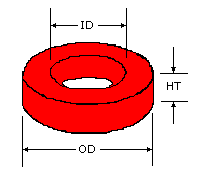|
|
|
MODULE V - FUNDAMENTALS OF ELECTRONICS
What is a Decibel? This is a relative power unit. At audio frequencies a change of one decibel (abbreviated dB) is just detectable as a change in loudness under ideal conditions. For a given power ratio the decibel change is calculated as: If we used voltage or current ratios instead then our formula becomes: Examples of using the Decibel The decibel units add and subtract. For example, if we had an amplifier stage with a voltage gain of 22 which from above is 26.85 dB gain, followed by a further amplifier stage which has a voltage gain of 17 (24.6 dB) then the total overall voltage gain is 22 * 17 = 374 (51.46 dB). |
|
Adding together the 26.85 dB plus the 24.6 dB = 51.45 dB, The minor difference was caused by my rounding to the nearesting second decimal place. TOROIDS What are toroids? These come in two types. Powdered Iron or Ferrites. Both introduce permeability. Toroids look exactly like doughnuts and come in various diameters, thicknesses, permeabilities and types depending upon the requency range of interest. Note the correct spelling, not torroids Some of the advantages of toroids are: 1. High inductance for the physical space occupied. 2. No interaction or coupling with adjacent components (unlike air wound and other inductors). 3. Various permeabilities are available. 4. Exceptional Q values when wound correctly and optimum core and windings selected. 5. Wide range of diameters and thicknesses. 6. Relatively low cost 7. Often simple to mount or secure mechanically. Some of the disadvantages of toroids are: 1. Nearly impossible to introduce variable tuning of the inductance. 2. Subject to some thermal drift.

Fig 1. - Toroid Core A typically popular type is made available by Amidon Associates and a representative example is the T50-2. This core is lacquered red (so you know the type) and has the following main properties. Being T50 it's outside diameter is 0.5", the ID is 0.3" and the thickness is 0.19" The permeabilities or in this case AL factors i.e. ( inductance per 100 turns2 ) are: TYPE COLOR AL Freq. Range T50-26 Yel-Wh
320uH
power freq.
This is only a small sample to give you an idea. Your turns required to give a certain inductance based on the above AL is as follows: N = 100 * Ö[ L / AL] Therefore to obtain an inductance of 3.685 uH using a T50-6 toroid would require 28 turns (of course I cheated again) but check it out on your calculator as I may have left in a deliberate mistake to see if you're awake. By the way don't get too paranoid about the exact number of turns because cores do vary in value anyway and particularly with temperature changes. Micrometals RF Design Software FREE Micrometals RF design software, RF-Toroid was written as a supplement to the Micrometals RF Application catalog. Much emphasis was put into calculating the location of the Self resonate frequencies for series and shunt inductors. RF-Toroid is for use DC to 300 MHz. Much research went in to the calculation and corrections from the standard formulas for low perm & phenolic cores to better predict the RF style of winding and application. Some features include SRF for series and shunt cores, peak Q curve ranges and 200 & 360 degree coverage to achieve the best product possible for the microwave designer who needs accurate and abundant information at the finger tips to compare one core to another simultaneously. The custom core feature allows for custom shaped cores, stacking cores side by side , ferrite cores and machining custom phenolic cores from plastic, wood, ect... Micrometals hope this tool will serve you well. Download Micrometals RF Design Software - 397Kb |
|
|
|
Copyright �2000-2002 [email protected] -- All Rights Reserved -- Designed by WebCreations



